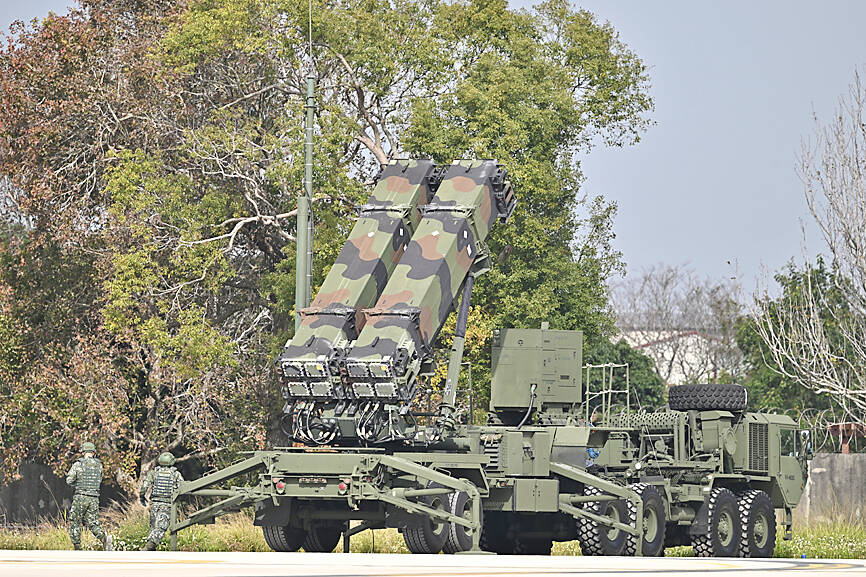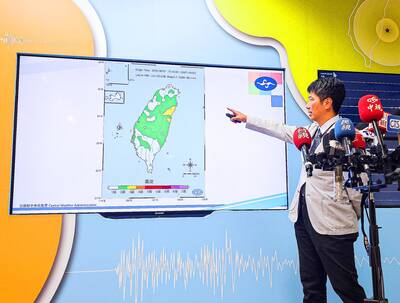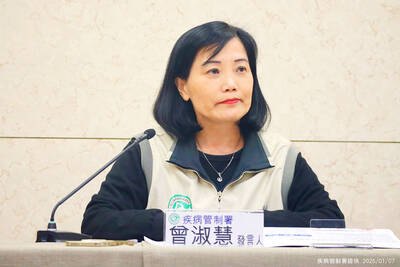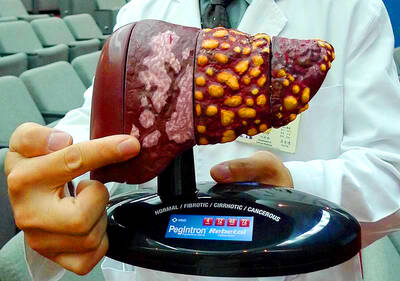The air force is to form its fourth Patriot missile-armed air defense battalion in anticipation of arms deliveries from the US this year and next, a source said on condition of anonymity yesterday.
The Ministry of National Defense has funded the procurement of PAC-3 Missile Segment Enhancement (MSE) systems with the surplus in the defense budget designated for purchasing a less-advanced version of the weapon, the source said.
Taiwan ordered hundreds of PAC-3 MSE systems and is likely to deploy them to defend the airspace over Hualien and Taitung counties, the source said.

Photo: Aaron Tu, Taipei Times
The systems have an estimated maximum altitude of between 45km and 60km, in comparison to the 24km maximum altitude of the PAC-3 system’s baseline variant, they said.
PAC-3 MSE systems have achieved superior performance by using larger, more powerful rockets, which reduce the number of missiles each launch vehicle could carry to 12, down from 15 previously, the source said.
The US is also expected to deliver the first of the three National Advanced Surface-to-Air Missile Systems (NASAMS) Taiwan ordered by the end of the year, the ministry said in February.
NASAMS could engage aerial targets as high as 40km, providing Taiwan with a medium-altitude air defense capability.
The air force is in the process of forming a battalion-level unit to deploy these weapons, the source said.
Separately, the US-based Aviation Week Network last week reported that Taiwan’s international drone-making alliance has quadrupled its membership to more than 200 companies since it was founded in September last year.
The Taiwan Excellence Drone International Business Opportunities Alliance was launched in a bid to align with US requirements to decouple drone supply chains from China, the US outlet cited Aerospace Industrial Development Corp chairman Hu Kai-hung (胡開宏), who also chairs the alliance, as saying.
Members are required to prove the provenance of their components, Hu said.
The alliance includes indigenous drone makers such as Geosat Aerospace & Technology and Thunder Tiger Group, as well as suppliers specializing in the manufacture of key components in drones, he said.
Taiwan faces challenges competing with China’s virtual monopoly over the sector, he added.
“Taiwan is a latecomer to the drone sector, but it can leverage its advanced technology and manufacturing capabilities to cooperate with a growing number of countries that want a reliable alternative to China,” Hu was quoted as saying.
The alliance has partners in the US and eastern Europe, including Estonia, Latvia, Lithuania and Poland, he said.
These nations make ideal partners because they have experience supporting Ukraine in its ongoing war against Russian aggression in a demonstration of their an antipathy to authoritarian expansionism, Hu was cited as saying.
Some of the alliance’s European members have been involved in autonomous military drones, he said.
Taiwan has been looking for manufacturers in Asia that have become wary of being dependent on Chinese drone suppliers, he said.
The alliance is increasingly confident with the security of its supply chains save for rare earths and other crucial materials, which remain under China’s control, Hu said.
Beijing’s weaponization of its control over rare earths and other resources in its trade war with the US is worrisome, he said, adding that some key raw materials utilized in drone making cannot easily be replaced if China cuts off its supply to Taiwan.

The Taipei Summer Festival is to begin tomorrow at Dadaocheng Wharf (大稻埕), featuring four themed firework shows and five live music performances throughout the month, the Taipei Department of Information and Tourism said today. The festival in the city’s Datong District (大同) is to run until Aug. 30, holding firework displays on Wednesdays and the final Saturday of the event. The first show is scheduled for tomorrow, followed by Aug. 13, 20 and 30. To celebrate the 30th anniversary of Disney Pixar's movie Toy Story, the festival has partnered with Walt Disney Co (Taiwan) to host a special themed area on

Aftershocks from a magnitude 6.2 earthquake that struck off Yilan County at 3:45pm yesterday could reach a magnitude of 5 to 5.5, the Central Weather Administration (CWA) said. Seismological Center technical officer Chiu Chun-ta (邱俊達) told a news conference that the epicenter of the temblor was more than 100km from Taiwan. Although predicted to measure between magnitude 5 and 5.5, the aftershocks would reach an intensity of 1 on Taiwan’s 7-tier scale, which gauges the actual effect of an earthquake, he said. The earthquake lasted longer in Taipei because the city is in a basin, he said. The quake’s epicenter was about 128.9km east-southeast

BE CAREFUL: The virus rarely causes severe illness or death, but newborns, older people and those with medical conditions are at risk of more severe illness As more than 7,000 cases of chikungunya fever have been reported in China’s Guangdong Province this year, including 2,892 new cases last week, the Centers for Disease Control (CDC) yesterday said it is monitoring the situation and considering raising the travel notice level, which might be announced today. The CDC issued a level 1 travel notice, or “watch,” for Guangdong Province on July 22, citing an outbreak in Foshan, a manufacturing hub in the south of the province, that was reported early last month. Between July 27 and Saturday, the province reported 2,892 new cases of chikungunya, reaching a total of 7,716

STAY VIGILANT: People should reduce the risk of chronic liver inflammation by avoiding excessive alcohol consumption, smoking and eating pickled foods, the physician said A doctor last week urged people to look for five key warning signs of acute liver failure after popular producer-turned-entertainer Shen Yu-lin (沈玉琳) was reportedly admitted to an intensive care unit for fulminant hepatitis. Fulminant hepatitis is the rapid and massive death of liver cells, impairing the organ’s detoxification, metabolic, protein synthesis and bile production functions, which if left untreated has a mortality rate as high as 80 percent, according to the Web site of Advancing Clinical Treatment of Liver Disease, an international organization focused on liver disease prevention and treatment. People with hepatitis B or C are at higher risk of